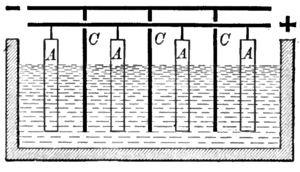Electrowinning

Electrowinning, also called electroextraction, is the electrodeposition of metals from their ores that have been put in solution via a process commonly referred to as leaching. Electrorefining uses a similar process to remove impurities from a metal. Both processes use electroplating on a large scale and are important techniques for the economical and straightforward purification of non-ferrous metals. The resulting metals are said to be electrowon.
In electrowinning, a current is passed from an inert anode through a liquid leach solution containing the metal so that the metal is extracted as it is deposited in an electroplating process onto the cathode. In electrorefining, the anodes consist of unrefined impure metal, and as the current passes through the acidic electrolyte the anodes are corroded into the solution so that the electroplating process deposits refined pure metal onto the cathodes.[1]
History
Electrowinning is the oldest industrial electrolytic process. The English chemist Humphry Davy obtained sodium metal in elemental form for the first time in 1807 by the electrolysis of molten sodium hydroxide.
Electrorefining of copper was first demonstrated experimentally by Maximilian, Duke of Leuchtenberg in 1883 [2]
James Elkington patented the commercial process in 1865 and opened the first successful plant in Pembrey, Wales in 1870.[3] The first commercial plant in the United States was the Balbach and Sons Refining and Smelting Company in Newark, New Jersey in 1883.
Applications
The most common electrowon metals are lead, copper, gold, silver, zinc, aluminium, chromium, cobalt, manganese, and the rare-earth and alkali metals. For aluminium, this is the only production process employed. Several industrially important active metals (which react strongly with water) are produced commercially by electrolysis of their pyrochemical molten salts. Experiments using electrorefining to process spent nuclear fuel have been carried out. Electrorefining may be able to separate heavy metals such as plutonium, caesium, and strontium from the less-toxic bulk of uranium. Many electroextraction systems are also available to remove toxic (and sometimes valuable) metals from industrial waste streams.
Process

Most metals occur in nature in their oxidized form (ores) and thus must be reduced to their metallic forms. The ore is dissolved following some preprocessing in an aqueous electrolyte or in a molten salt and the resulting solution is electrolyzed. The metal is deposited on the cathode (either in solid or in liquid form), while the anodic reaction is usually oxygen evolution. Several metals are naturally present as metal sulfides; these include copper, lead, molybdenum, cadmium, nickel, silver, cobalt, and zinc. In addition, gold and platinum group metals are associated with sulfidic base metal ores. Most metal sulfides or their salts, are electrically conductive and this allows electrochemical redox reactions to efficiently occur in the molten state or in aqueous solutions.
Some metals, such as nickel do not electrolyze out but remain in the electrolyte solution. These are then reduced by chemical reactions to refine the metal. Other metals, which during the processing of the target metal have been reduced but not deposited at the cathode, sink to the bottom of the electrolytic cell, where they form a substance referred to as anode sludge or anode slime. The metals in this sludge can be removed by standard pyrorefining methods.
Because metal deposition rates are related to available surface area, maintaining properly working cathodes is important. Two cathode types exist, flat-plate and reticulated cathodes, each with its own advantages. Flat-plate cathodes can be cleaned and reused, and plated metals recovered. Reticulated cathodes have a much higher deposition rate compared to flat-plate cathodes. However, they are not reusable and must be sent off for recycling. Alternatively, starter cathodes of pre-refined metal can be used, which become an integral part of the finished metal ready for rolling or further processing.[1]
References
- 1 2 Copper, technology & competitiveness., Diane Publishing, 1988, ISBN 1-4289-2245-8 pp 142-143
- ↑ Alexander Watt, Electro-Deposition a Practical Treatise, Read Books (2008), p. 395. ISBN 1-4437-6683-6
- ↑ John Baker Cannington Kershaw, Electro-Metallurgy, BiblioBazaar, LLC, 2008. ISBN 0-559-68189-5
External links
- High Throughput Electrorefining of Uranium in Pyro-reprocessing
- Aluminum Electrowinning and Electrorefining
- How Hydrometallurgy and the SX/EW Process Made Copper the "Green" Metal
- Copper Electrowinning
